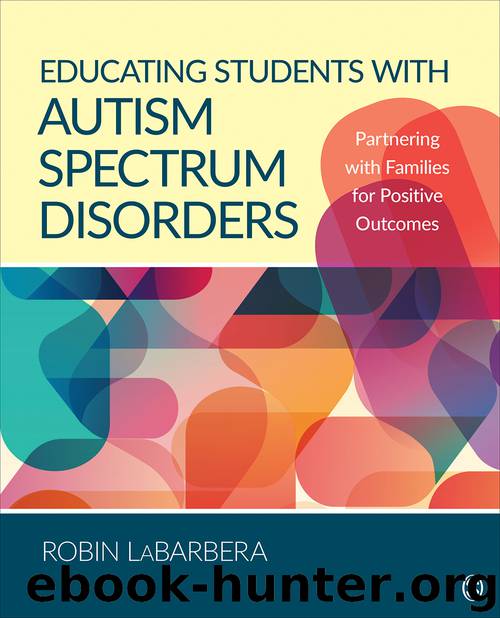Educating Students with Autism Spectrum Disorders by Robin LaBarbera

Author:Robin LaBarbera
Language: eng
Format: epub
Published: 2017-12-21T11:13:56.021137+00:00
TEACCH
TEACCH (Treatment and Education of Autistic and related Communication-handicapped CHildren), established at the University of North Carolina, is an evidence-based intervention based on evidence that individuals with ASD share a number of characteristics (Mesibov & Shea, 2010). The TEACCHing approach capitalizes on the understanding that individuals with ASD have strength and preference for processing visual information, have difficulty with sequencing, are often very distractible, have difficulty with concepts of time, are attached to routines, and have marked sensory preferences and aversions. The approach gives particular importance to the use of structure—organizing time, space, and sequences—to make learning activities easier to perform for students with autism (Mesibov & Shea, 2010).
The TEACCH program recommends four kinds of structure. First is the physical structure (using elements such as furniture arrangement or visual cues that show a student which activities will occur in certain areas), and reducing environmental sources of distraction or overstimulation by not seating a student near a door or window. The second type of structure involves organizing a sequence of events and making the schedule understandable for the child. These schedules can take the form of helping the student make a transition to a new space or new activity. The third type of structure refers to individual tasks, using visual means to show what the student is supposed to do, how long the activity will last, how he can see that he is making progress toward being finished, how he can know when the activity is finished, and what he will do next. The fourth kind of structure involves linking individual tasks into a sequence of activities, which helps increase the time the student spends engaged in productive activities (Mesibov & Shea, 2010).
Individual work systems are a part of TEACCH that we will discuss here. Hume, Plavnick, and Odom (2012) defined individual work systems as visually organized spaces where children practice acquired skills. A work system communicates the task the student is supposed to do, how much work is to be completed, how students know they are finished, and what to do when they are finished. Individual work systems also promote students’ generalization of skills across settings. That means that students can acquire and practice a skill in one setting with the support of the work system and then use that skill across settings without the support of the system (Hume et al., 2012).
Whereas a picture schedule directs a student where to go, a work system instructs a student what to do once he or she arrives at the designated area. A work system provides required information so that a student can complete a task without adult prompting by teaching the student to attend to visual cues rather than verbal instructions. Work systems can be used with any task or activity, across settings, and for individuals at all levels of functioning.
Download
This site does not store any files on its server. We only index and link to content provided by other sites. Please contact the content providers to delete copyright contents if any and email us, we'll remove relevant links or contents immediately.
| Behavioral Disorders | Communicative Disorders |
| Gifted Students | Inclusive Education |
| Learning Disabled | Mentally Disabled |
| Physically Disabled |
The Art of Coaching Workbook by Elena Aguilar(51002)
Trainspotting by Irvine Welsh(21524)
Twilight of the Idols With the Antichrist and Ecce Homo by Friedrich Nietzsche(18510)
Fangirl by Rainbow Rowell(9109)
Periodization Training for Sports by Tudor Bompa(8175)
Change Your Questions, Change Your Life by Marilee Adams(7641)
This Is How You Lose Her by Junot Diaz(6804)
Asking the Right Questions: A Guide to Critical Thinking by M. Neil Browne & Stuart M. Keeley(5658)
Grit by Angela Duckworth(5525)
Red Sparrow by Jason Matthews(5392)
Paper Towns by Green John(5093)
Room 212 by Kate Stewart(5041)
Ken Follett - World without end by Ken Follett(4647)
Housekeeping by Marilynne Robinson(4349)
The Sports Rules Book by Human Kinetics(4302)
Double Down (Diary of a Wimpy Kid Book 11) by Jeff Kinney(4209)
Papillon (English) by Henri Charrière(4199)
The Motorcycle Diaries by Ernesto Che Guevara(4020)
Exercise Technique Manual for Resistance Training by National Strength & Conditioning Association(3963)
